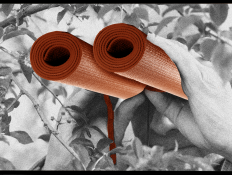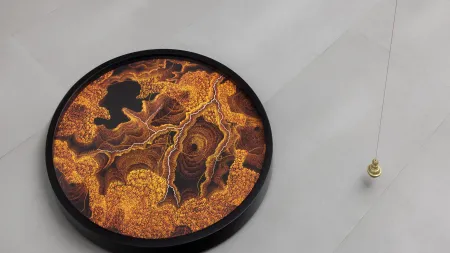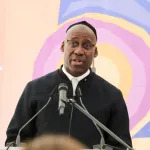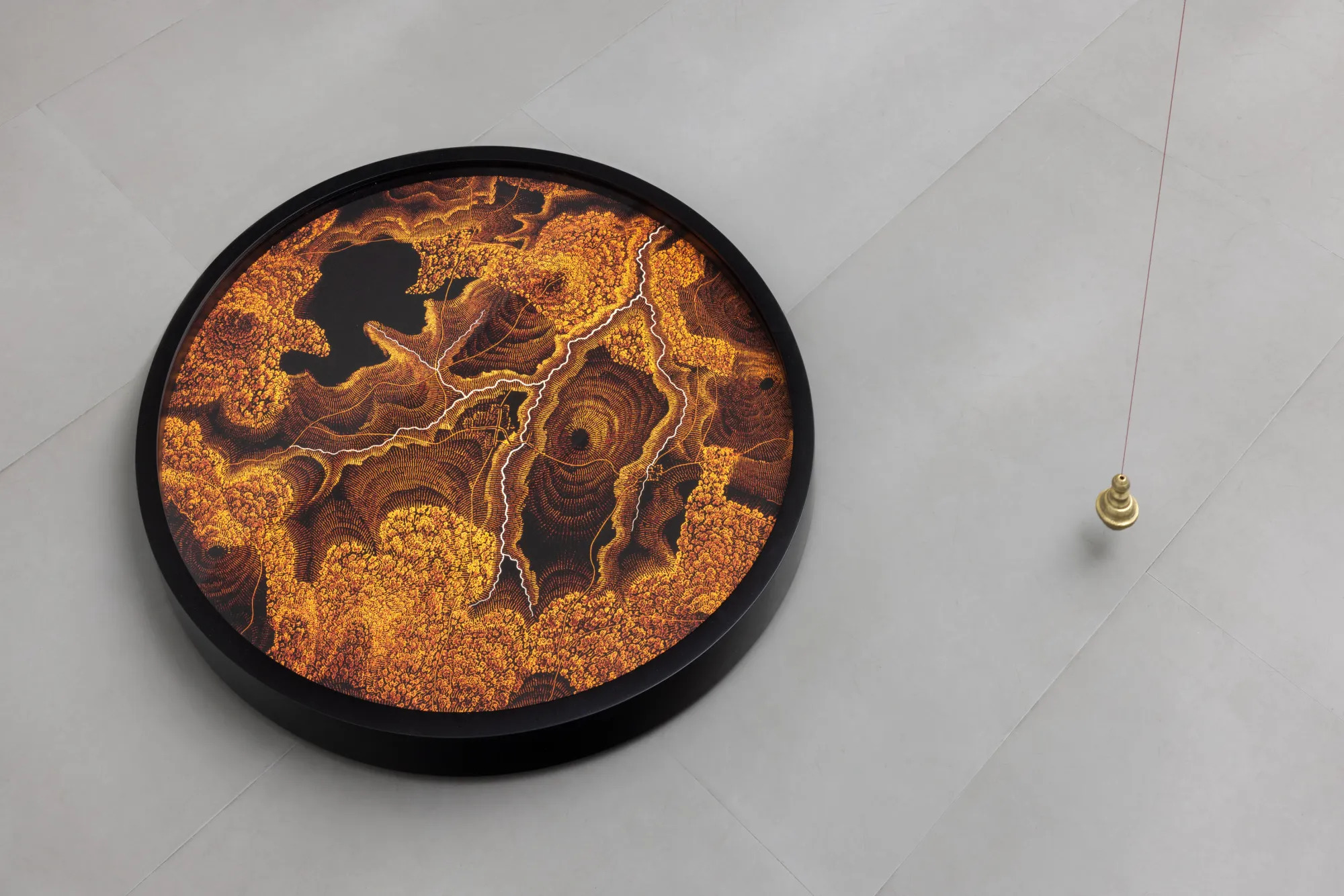
The maps won’t tell you where you are in Dor Guez’s new solo exhibition at Berlin’s Carlier | Gebauer gallery, so don’t bother trying to find a due north. The only directive is the exhibition’s title—Not knowing is a good place to start.
“We can recognize the topography—we see the trees, valleys, rivers, and mountains—but we have no idea where we are and no index to help us. And this really highlights the importance of ‘not knowing,’ which is different from lacking information,” Guez told ARTnews of his 2023 work Amid Imperial Grids, a print series of manipulated maps that remove all human markers (such as border lines or town names) and are reshaped as circles. The maps were originally exhibited last year at Felix Nussbaum House, a museum in Osnabrück, Germany housing the works of the German-Jewish surrealist. They were meant as a response to Nussbaum’s 1939 painting The Refugee, which includes a globe missing geopolitical demarcations, referencing his inability to find refuge in Nazi Europe.
“What you see is knowledge in itself, as one can identify the raw topography; it’s just that you don’t have many tools to process that information into knowledge or informed judgement,” Guez said.
An openness to not knowing is central to the practice of Guez, a Jaffa-based artist born in Jerusalem to a Palestinian Christian mother and father of Jewish Tunisian descent. His work often centers his own family and larger untold histories. In the current exhibition at Carlier | Gebauer, Guez’s first since the October 7 Hamas attack, he presents works created over the past year that tell a complex story of displacement and forced migration.
Above the disorienting maps, which are installed on the floor, is an ongoing photographic series of suitcases that belonged to immigrants and refugees. Guez began this series with the suitcase that his grandmother, Gina, used when immigrating from Tunis to Israel in the 1950s. The family left with whatever prized possessions they could fit into one suitcase per person, after they’d been forced into work camps during the Nazi occupation of Tunisia. Guez also associates the image of a timeworn suitcase with the story of his maternal grandparents, who hid in the basement of a church in Lydda in 1948 as their property was nationalized by the new state of Israel.
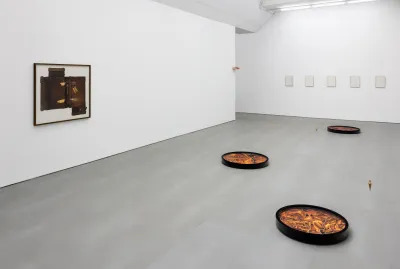
These suitcases are literally unfolded and unpacked, no longer suitable containers but weathered testaments to journeys long past. Guez photographs all six sides of the suitcases and then stitches them into composite images that resemble templates or floor plans, images that are optically impossible in reality. Each photograph is printed to the actual size of the suitcase, allowing viewers to read every stamp and label and imagine what could fit inside.
“The idea of leaving and migrating in haste, hurriedly, knowing that you’re not going to return and taking what you can physically carry with or on your body—thinking of the limited volume of what you can take with you, what’s important and what isn’t—is a question that occupies me in many of my works and also in this exhibition,” Guez said.
A new series debuted in the exhibition is Khobiza, the Arabic word for edible mallow plants that grow wild in the region. Often harvested and eaten during times of scarcity, such as war, khobiza literally means ‘bread’ in Arabic and refers to its role as a source of sustenance. After not working at all during the first few months of the war, Guez began making this photographic series in late winter, when khobiza were in season and after learning that his extended family in Gaza was harvesting and eating it.
Botany is a constant theme in Guez’s work, and in his 2019-2021 series Lilies of the Field, he studied and photographed the early 20th century pressed-flower albums created by the American Colony in Jerusalem. Guez had intended to dry the root, stem, and leaves of the mallow plants between sheets of white pressing paper, like botanical specimens, but at the last minute decided to freeze the process at the fragile moment before a living plant becomes history. His Khobiza float between the milky papers, either coming toward the viewer or receding into the white. Like the suitcases, the khobiza are printed to actual size and look so real that a viewer is likely to be unsure whether there are plants behind the frames.
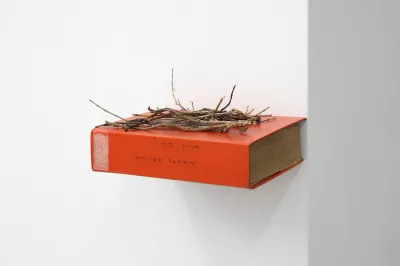
Perched above the floor-installed maps, the Khobiza series, and Suitcase No. 2 and Suitcase No. 3 is Nest, a literal bird’s nest that wild pigeons made on top of a red-bound book in Guez’s studio. This bizarre readymade intuitively mirrors and connects the works in the show: the round shape of the maps, the harvested twigs, and the attempt to find a home.
The book that is the nest’s foundation—chosen by the pigeons not for any philosophical reason, of course, but because it’s the fattest book in Guez’s library—is a translated Biblical dictionary of terms in Hebrew and Aramaic. A translated dictionary is, by definition, a submission to ‘not knowing.’
“To make art, to connect with someone who may be different from you—whether in language, culture or beliefs—you need to set aside your prejudices,” Guez said. “Embracing that sense of disorientation can actually guide you on the right path towards this person.”
Guez intentionally avoided exhibiting his work until now, canceling or postponing shows that were planned before October. Now he’s preparing to exhibit several times in the coming year: in a group exhibition at K21 museum in Germany, a solo show at Goodman Gallery in New York, a group show at Goodman Gallery’s Capetown outpost, and participation in a biennale in South America.
When asked why he opted not to publicly share his work since the war started, Guez said, “I felt that as my work challenges definitions, identities, and concepts of nationalism, it is not the right moment for it. It feels like there is no room for ‘not knowing’. My kind of art cannot thrive in an environment where listening is absent. My work doesn’t exist to prove whether someone is right or wrong—that’s not my role.”
“It’s not that I believe we are in a period of listening right now, either,” Guez added. “However, I realized that choosing silence isn’t necessarily a better option.”
New Alliance of Major Art Fairs Commits to Slashing Carbon Emissions, Berlin’s Cultural Affairs Official Targeted for Palestine Stance: Morning Links for September 26, 2024
Berlin’s Pergamon Museum Closes for Major Renovations, Will Fully Reopen in 14 Years
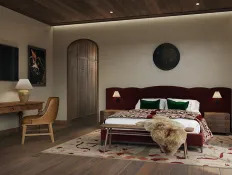
The ‘Heli-Skiing Capital of the World’ Gets a Game-Changing New Luxury Resort
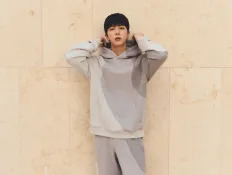
EXCLUSIVE: BTS’ Jin Named Newest Alo Yoga Global Ambassador as the Brand Expands in South Korea
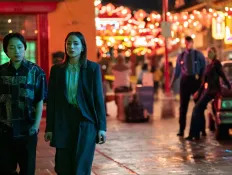
New on Hulu: November 2024

Calipari Campaign Cash Stands Out Among College Sports Figures
